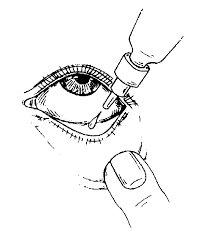Chloramphenicol+dexamethasone
About Chloramphenicol+dexamethasone
Chloramphenicol+dexamethasone is used for the treatment of bacterial eye or ear infections. It is used to treat eye infections such as conjunctivitis (inflammation of the conjunctiva) and ear infections such as otitis media (middle ear infections) in children with ear tubes and otitis externa (outer ear infections) in adults and children.
Chloramphenicol+dexamethasone is a combination of two medicines: Chloramphenicol and Dexamethasone. Chloramphenicol is an antibiotic that acts by interfering with the formation of essential proteins required for bacterial growth. Dexamethasone is a steroid that reduces inflammation and symptoms associated with infection, such as redness and irritation. It works by inhibiting the chemicals, such as prostaglandins, that cause inflammation.
Use Chloramphenicol+dexamethasone as prescribed by your doctor. The common side-effects of Chloramphenicol+dexamethasone are burning/stinging sensation or redness, temporary blurred vision, watery eyes, eye discomfort, eye irritation, increased sensitivity to light, and ear discomfort (when used as ear drops). Most of these side effects of Chloramphenicol+dexamethasone do not require medical attention and gradually resolve over time. If these side effects persist longer, please consult your doctor.
Do not use Chloramphenicol+dexamethasone if you are allergic to any of its contents. Before using Chloramphenicol+dexamethasone, inform your doctor if you have fungal infections, viral infections, such as herpes simplex or varicella, or parasitic infections, such as amoebiasis. Do not use Chloramphenicol+dexamethasone if you have tuberculosis, damaged cornea, ulceration, lesions with missing skin that cover the eye or ear, and increased pressure inside the eye. Pregnant and breastfeeding women should use Chloramphenicol+dexamethasone with proper consultation and caution.
Uses of Chloramphenicol+dexamethasone
• Ear Infection Treatment: Chloramphenicol+dexamethasone can help treat ear infections like otitis externa by killing bacteria that cause them.
• Relief from Ear Pain: Chloramphenicol+dexamethasone acts as a local anaesthetic, which blocks pain signals from the nerves to the brain, decreasing the ear pain sensation.
• Reduction of Inflammation: Chloramphenicol+dexamethasone also reduces inflammation and soothes irritation caused by ear infections.
• Treatment of Bacterial Conjunctivitis: Chloramphenicol+dexamethasone are effective in managing bacterial eye infections, helping to reduce symptoms such as redness, swelling, and discharge.
• Management of Corneal Ulcers: Chloramphenicol+dexamethasone is prescribed for the treatment of corneal ulcers, aiding in healing and preventing complications associated with open sores on the cornea.
• Relief from Eye Infections: Chloramphenicol+dexamethasone relieves various bacterial eye infections, promoting eye health and minimising discomfort.
Medicinal Benefits
Chloramphenicol+dexamethasone is a combination of two medicines: Chloramphenicol and Dexamethasone. Chloramphenicol is a broad-spectrum antibiotic that acts against gram-positive and gram-negative bacteria. It acts by interfering with the formation of essential proteins required for bacterial growth. Dexamethasone is a steroid medicine with anti-inflammatory properties and acts by inhibiting the chemicals, such as prostaglandins, that cause inflammation. It also reduces symptoms associated with infection, such as redness and irritation.
Directions for Use
- Follow your doctor's instructions on the dosage and timing of this medication to ensure safety.
- For Eye use: Lie down and tilt your head backwards. Pull your lower eyelid gently with your index finger to form a pocket. Instil the number of drops as advised by the doctor into the pocket of the lower eyelid. Close your eyes for 1-2 minutes.
- For Ear use: Lie on your side or tilt your head so the ear faces up and instil the advised number of drops into the ear.
- To prevent contamination, do not touch the tip of the dropper to your eye, ear, or any surface.
Storage
Side Effects of Chloramphenicol+dexamethasone
- Burning/stinging sensation
- Redness
- Temporary blurred vision
- Watery eyes
- Eye discomfort
- Eye irritation
- Increased sensitivity to light
- Ear discomfort (when used as ear drops)
Drug Warnings
Before using Chloramphenicol+dexamethasone, inform your doctor if you have vision problems, severe pain in the eye, sensitivity to light, inflammation of the eye, a rash on the scalp or face, the black or coloured part of the eye looks unusual, foreign body in the eye, recurrent eye infection, glaucoma (raised pressure in the eye), dry eyes, eye injury or eye surgery, or if you are using any other eye drops or eye ointment. It is advised to check with your doctor before using Chloramphenicol+dexamethasone if you are pregnant or breastfeeding. Avoid driving, or operating machines since the administration of eye drops may cause temporary blurred vision. Chloramphenicol+dexamethasone should be used for children only when advised by a doctor.
Drug Interactions
Drug-Drug Interaction: Chloramphenicol+dexamethasone may interact with an anti-cancer agent (methotrexate), immunosuppressant (azathioprine), antiviral drug (ritonavir), and a medication used to treat HIV (cobicistat).
Drug-Food Interaction: No interactions found.
Drug-Disease Interaction: Inform your doctor if you have any fungal infection, viral infection, such as herpes simplex or varicella, parasitic infection, tuberculosis, damaged cornea, ulceration, and glaucoma (increased pressure inside the eye) before starting Chloramphenicol+dexamethasone.
Drug-Drug Interactions Checker List:
Safety Advice

Alcohol
unsafeAlcohol may affect your ability to fight infections. So, it is recommended to avoid alcohol until your condition improves.

Pregnancy
consult your doctorPlease consult your doctor if you are planning to become pregnant or already pregnant before starting Chloramphenicol+dexamethasone.

Breast Feeding
cautionPlease consult your doctor if you are breastfeeding before starting the treatment with Chloramphenicol+dexamethasone.

Driving
unsafeChloramphenicol+dexamethasone may affect your vision. So, do not drive or operate heavy machinery until your vision is clear.

Liver
cautionChloramphenicol+dexamethasone should be used with caution in patients with liver diseases.

Kidney
cautionChloramphenicol+dexamethasone should be used with caution in patients with kidney diseases.

Children
consult your doctorChloramphenicol+dexamethasone should be used for children only when advised by a doctor.
Habit Forming
Diet & Lifestyle Advise
Ear infection
- Manage stress, eat healthily, drink plenty of water, exercise regularly, and get plenty of sleep.
- Eat food rich in antioxidants such as berries, spinach, kidney beans, dark chocolate, etc.
- Know your allergy triggers, such as pollen, dust and other factors.
- Avoid getting things like shampoo, soap, and water into the ear as it can cause itching.
- Do not poke or scratch the ear as it can cause damage to the ear canal, leading to inflammation. The inflamed skin can be infected by bacteria or fungi, which can cause infections in the ear.
Eye infections:
- Do not rub your eyes even though some ophthalmic drugs make your eye itchy.
- If you wear contact lenses: Clean and replace contact lenses more often. Never share contact lenses. Always remember to wash your hands before inserting and after removing the contact lens.
- Avoid staring at the digital screens for longer durations. Rest your eyes every 20 minutes.
- Avoid or limit the intake of alcohol and caffeine.
Special Advise
Avoid prolonged exposure to sunlight while using Chloramphenicol+dexamethasone as it may cause increased photosensitivity (sensitivity to light).
Patients Concern
Disease/Condition Glossary
Bacterial eye infection: A bacterial eye infection occurs when bacteria invade any part of the eyeball or its surrounding tissues, including the cornea (clear front surface of the eye) and the conjunctiva (thin membrane lining the outer eye and inner eyelids). A bacterial eye infection symptoms include red eyes, pain, swelling of the eyes, watery eyes, itching, and blurry vision. Some very common eye infections are conjunctivitis (the inflammation and irritation of the eye's mucous membrane (conjunctiva), stye (bump on the eyelid), uveitis (inflammation of the uvea-middle layer of the eye), marginal keratitis (inflammation of the cornea), and blepharitis (inflammation of the eyelids).
Bacterial ear infection: Bacterial ear infection occurs when bacteria infect the outer or middle ear. The most common bacterial strains that cause ear infections are Streptococcus pneumoniae and Haemophilus influenzae. Symptoms include earache (sharp, sudden pain or a dull, continuous pain), the feeling of fullness in the ear, ear drainage, and muffled hearing. Treatment may include over-the-counter painkillers, anti-allergic drugs, antibiotics, and steroids.
FAQs
Chloramphenicol+dexamethasone is used for the treatment of bacterial eye or ear infections. It is used to treat eye infections such as conjunctivitis (inflammation of the conjunctiva) and ear infections such as otitis media (middle ear infections) and otitis externa (outer ear infections).
Chloramphenicol+dexamethasone is a combination of two medicines: Chloramphenicol and Dexamethasone. Chloramphenicol is an antibiotic that stops the growth of infection-causing bacteria. Dexamethasone is an anti-inflammatory medicine that reduces symptoms associated with infection, such as redness and irritation.
You must maintain at least a 20-30 minute gap after application of Chloramphenicol+dexamethasone if you are using more than one ear drop formulation.
It is advised to remove your contact lens if you are wearing it while administering eye drops. Also, remember to wash your hands before and after administering eye drops to avoid contamination.
If you use other eye ointments/drops along with Chloramphenicol+dexamethasone, it is advised to maintain a gap of at least 5-10 minutes after each administration. Also, use eye drops before applying any ointments.
Before using Chloramphenicol+dexamethasone, consult the doctor if you have undergone eye surgery in the past six months as Chloramphenicol+dexamethasone contains chloramphenicol which may delay corneal wound healing.
Lie down and tilt your head back. Using your index finger, gently pull down your lower eyelid to form a pocket. Instil the number of drops prescribed by the doctor into the pocket. Close your eyes and keep them closed for 1–2 minutes.
Yes, Chloramphenicol+dexamethasone may temporarily cause blurry vision, which can affect your ability to drive or operate machinery. Avoid these activities until your vision is clear and you feel fully alert.
If you accidentally use an excess of Chloramphenicol+dexamethasone, rinse off your eyes with plenty of water. If irritation occurs or persists, consult the doctor immediately.
No, you should not stop using Chloramphenicol+dexamethasone even if your symptoms are relieved as it may cause the infection to return or worsen. Always complete the course of treatment as prescribed by the doctor to get full benefits.
Chloramphenicol+dexamethasone should be stored in a cool and dry place away from sunlight. Keep it out of sight and reach of children.
Chloramphenicol+dexamethasone starts working as soon as you start using it. However, it may take some days for noticeable improvement that can vary depending on the severity of the infection.
The side effects of Chloramphenicol+dexamethasone include temporary blurred vision, redness of the eye and stinging/burning sensation. Consult the doctor if any of these symptoms persist or worsen.






